|
by Stefan Stenudd
|
MENU |
FREE READING |
HEXAGRAMS |
The I Ching Trigrams Eight Basic PrinciplesI Ching consists of 64 hexagrams, but it's really the eight trigrams they are combinations of that are the basic components of the I Ching. The trigrams explain the nature of each hexagram. Here they are, and the principles they represent.
Each of the eight trigrams represents a basic force of nature. They are:
Since the trigrams consist of three lines that can either be broken or whole, the number of possible combination of lines is eight (2 x 2 x 2). And each of the hexagrams is a unique combination of two trigrams. That makes for a total of 64 (8 x 8). That's the whole of the I Ching. When using the I Ching for divination, a hexagram is chosen by one or other method of chance — like throwing sticks or coins, or simply by using a random number generator, as does the online app on this website. Then it's just to look up the hexagram in the book and read its text. But that text, and the meaning of the hexagram, is decided by the two trigrams it contains, with particular consideration of which one is the upper and which one is below. The trigrams are the basic working component in the hexagrams. They are, so to speak, the atoms making up the molecule. The trigrams carry concrete and specific meanings, which when combined lead to the characteristics of the hexagram.
The Yin and Yang LinesOf course, the trigrams are in turn made up of three full or broken lines, which represent yin and yang, the old polarities of Chinese cosmology. If the hexagram is the molecule and the trigrams are its atoms, then the lines are the nucleus and electrons of the atom.But this binary system of lines is not what gives concrete meaning to the hexagrams. For that, they are just too abstract. Also, they are probably combined into trigrams not as much for their yin-yang values as for the image they form.
That's not all there is to the combinations of lines in the trigrams, but it indicates that their combinations of yin and yang are not necessarily to be interpreted as saying something definite about their characteristics. The only exceptions are the Heaven and Earth trigrams, representing pure yang and yin respectively. It is most likely from their appearance that the lines got their forms — yang as full and yin as broken — from the visual impression. In traditional Chinese cosmology, Heaven is perfect and Earth is flawed, so the latter had to be a broken line.
Examples of Trigram CombinationsNow, when the trigrams are combined into hexagrams, it is often quite obvious what the meanings of the latter must be. What basic forces are involved, and which one of them is on top, is what decides the characteristics of the hexagram. Here are a few examples:
Consider the TrigramsSo, when you use the I Ching for divination, don't forget to consider the trigrams carefully. Also think of which one is above and which one below. What basic natural forces are involved, and how do they interact?It may not always be very clear how the trigram combination leads to the meaning of the hexagram, but contemplating the question gives a deeper understanding of the symbolic system of the I Ching. Like all methods of divination, it works better the more familiar you are with it. Knowledge helps you evaluate what the I Ching says and how to interpret it in your own life. Here are the eight trigrams and their meanings in more detail:
1 — Heaven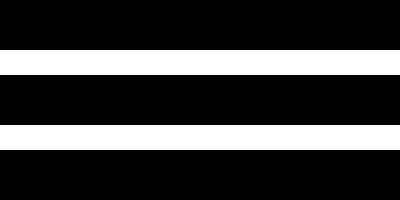
It consists of three solid lines, i.e. Yang lines. Yang is the principle of light and the heavenly, so it has to be represented in abundance in the trigram of Heaven. It's the ultimate Yang. The Chinese character for this trigram, shown above to the right, suggests the drying light of the sun.
2 — Lake
The combination of lines may seem odd at first glance: Yin (the earthly) resting on two Yang (the heavenly). But the lake is an image of the sea, the primordial sea that most ancient creation myths contain as a primordial element. Since Heaven is the creative force in Chinese tradition, it must lie beneath what seems to be the origin of everything. So, beneath the depth of the ocean hides the creative first cause: Heaven. The trigram represents the open, because with earth on top it gives room for fruition on the surface, from heavenly forces hidden below. The Chinese character for the trigram, to the right above, oddly means cash and exchange as well as weight. It may refer to the abundance of such a great body of water, and the nourishment it conceals.
3 — Fire
The lines show the earthly (Yin) surrounded by the heavenly (Yang). That brings a boost of potency to the earthly, enough to make it burst into flames. Earth is consumed by the heavenly forces surrounding it, therefore the trigram stands for breaking free, leaving to another state of being. The Chinese character of this trigram (above to the right) uses the symbol of birds flying away, for its meaning of departure and separation.
4 — Thunder
The trigram consists of two Yin (earthly) lines above a Yang (heavenly) one. So much earth on top of heaven can't be stable. Also, when heaven is pressured by so much earth, it is bound to react. The combination of lines also suggests that this is a heavenly activity that affects earthly life — from its hiding, which is in a mysterious way. The trigram's Chinese character (above to the right) also means quake and tremor, as well as shake and excite.
5 — Wind
The lines it consists of speak about it in their symbolic way. Two Yang (heavenly) lines above one Yin (earthly). The great powers from above affect everything on earth. As science has progressed, we have learned it is indeed the case, more so than anyone in antiquity could fathom. Towards this magnitude, what can we be but obedient? Still, the wind mainly expresses itself rather gently, not to mention its own invisible shape. So, it is in itself a symbol of the gentle. It's also obedient, in the way it usually rounds any object — except for when in rage. The Chinese character (above to the right) has the same meaning of modest and obedient. It also stands for the direction southeast.
6 — Water
The difference between what this trigram represents and the second one, the Lake, is subtle. Shouldn't the lake, with its depth, be more abysmal than water? But the lake is usually experienced by its surface, not its depth, whereas water always insists on flowing downwards, seemingly forever. Water is heading for the abyss. The lines also imply this characteristic of water. A Yang (heavenly) line surrounded by Yin (earthly) lines. Water is earthbound, but moves of its own will, in spite of this captivity. It strives to go underground, but still it is stopped by ground, eventually — though that can be very deep down. The Chinese character for the trigram (above to the right) means pit, hole or trap, expressions of the downward movement of water. It also means crisis, probably from the threat of something in nature behaving in its own mysterious way, moving towards regions out of our control.
7 — Mountain
The lines of the trigram form a simple mountainous shape: the full Yang line on top, and the two broken Yin lines below. The lines also suggest the mighty reach of a mountain — earth upon earth (Yin) until the sky (Yang) is reached. The Chinese character (above to the right) is exclusively used for this trigram, and has no other meaning according to the dictionaries. It is used as a radical, though, a component in other Chinese characters. As such, it implies something good, and may also refer to stopping. It signifies northeast.
8 — Earth
The trigram represents the receptive, since that is traditionally seen as the role of earth in relation to heaven. It also represents the field on which is grown what we need to survive. The Chinese character for the trigram (above to the right) stands for earth and the female, which are connected in the symbolism of Yin and Yang. Yin is regarded as the female quality, and Yang the male, in the cosmology of Yin and Yang. The major opposites of the world, heaven and earth, are the greatest expressions of Yang and Yin in old Chinese cosmology. So, it's between what these two trigrams symbolize that everything else in the world is enclosed. Therefore, the other six trigrams are little more than different mixes of the first and the last trigram.
The 64 I Ching HexagramsAn I Ching hexagram is composed of two trigrams. Each of the 64 hexagrams has its own name, meaning, and divinatory text. Here they all are, in the traditional order. Click on the image of an I Ching hexagram to get to its webpage.
|
Some of my booksClick the image to see the book at Amazon (paid link).
|
Menu
Free I CHING Reading
I CHING Hexagrams
I CHING Trigrams
YIN and YANG
I CHING Books
Comment
Cookies
My Other Websites
Taoistic
Tarot Card Meanings
Complete Horoscope
Qi Energy Exercises

Stefan Stenudd
I'm a Swedish author and aikido instructor. In addition to fiction, I've written books about Taoism as well as other East Asian traditions. I'm also a historian of ideas, researching ancient thought and mythology. Click the image to get to my personal website.
 Hexagram 12 consists of the Heaven trigram above and the Earth trigram below. It is quite outstanding, since it represents the polarities of yin and yang in a pure form and proper order: Heaven (yang) above Earth (yin). As it is and should be. The hexagram is called Standstill or Stagnation. Of course it is, since this is the normal order of things. Nature is in balance and nothing happens. That may be sweet, but it is not eventful.
Hexagram 12 consists of the Heaven trigram above and the Earth trigram below. It is quite outstanding, since it represents the polarities of yin and yang in a pure form and proper order: Heaven (yang) above Earth (yin). As it is and should be. The hexagram is called Standstill or Stagnation. Of course it is, since this is the normal order of things. Nature is in balance and nothing happens. That may be sweet, but it is not eventful. The opposite is hexagram 11, where the world is turned upside-down. Heaven is below and Earth above. A strange thing, indeed. The name of the hexagram is Peace — and for sure, that's far more rare than we want it to be. It can be a peaceful thing, because yin and yang are in balance, albeit upside-down. But also, when Earth rests upon Heaven, even the mighty force of the latter is restrained, if not to say muffled. It is another kind of stillness than the one shown by hexagram 12, but stillness it still is.
The opposite is hexagram 11, where the world is turned upside-down. Heaven is below and Earth above. A strange thing, indeed. The name of the hexagram is Peace — and for sure, that's far more rare than we want it to be. It can be a peaceful thing, because yin and yang are in balance, albeit upside-down. But also, when Earth rests upon Heaven, even the mighty force of the latter is restrained, if not to say muffled. It is another kind of stillness than the one shown by hexagram 12, but stillness it still is. Another kind of stillness would be the Mountain resting on Earth. Again as it is and should be. But that's not completely true to the ancient mind. The Mountain grows out of the soil and its natural place, therefore, is below it. Earth is unstable and the mountain is not, so when their places are reversed even the solid mountain risks breaking, like in an earthquake. Indeed, this the 23rd hexagram is called Splitting Apart. Even the image of the hexagram suggests it, with a crack all the way down under the top line.
Another kind of stillness would be the Mountain resting on Earth. Again as it is and should be. But that's not completely true to the ancient mind. The Mountain grows out of the soil and its natural place, therefore, is below it. Earth is unstable and the mountain is not, so when their places are reversed even the solid mountain risks breaking, like in an earthquake. Indeed, this the 23rd hexagram is called Splitting Apart. Even the image of the hexagram suggests it, with a crack all the way down under the top line. The reverse, with the Mountain below the Earth, is hexagram 15, which is called Modesty. Contrary to the previous hexagram, it's a positive one bringing good tidings — provided modesty is used, like a mountain hiding most of its huge body under the surface of the earth. When the Earth rests on the Mountain, things are as they should be, stable and safe.
The reverse, with the Mountain below the Earth, is hexagram 15, which is called Modesty. Contrary to the previous hexagram, it's a positive one bringing good tidings — provided modesty is used, like a mountain hiding most of its huge body under the surface of the earth. When the Earth rests on the Mountain, things are as they should be, stable and safe. Let's finish with a dramatic duo — that of Fire and Thunder. Combining them, we immediately think of lightning, the fire from the sky. What makes the most sense, then, is having Fire below the Thunder, like a lightning bolt initiated by the heavenly storm strikes the ground and causes fire. That's hexagram 55, called Abundance or Fullness. A spectacular thing — for everyone not at the spot where lightning strikes. It shows the power of Heaven when it is the most sensational. It may be scary and dangerous, but it is a great show.
Let's finish with a dramatic duo — that of Fire and Thunder. Combining them, we immediately think of lightning, the fire from the sky. What makes the most sense, then, is having Fire below the Thunder, like a lightning bolt initiated by the heavenly storm strikes the ground and causes fire. That's hexagram 55, called Abundance or Fullness. A spectacular thing — for everyone not at the spot where lightning strikes. It shows the power of Heaven when it is the most sensational. It may be scary and dangerous, but it is a great show. The opposite, with Fire above the Thunder, is more difficult to relate to, since it has no real baring on life on Earth. It's Heaven making its own spectacle, none of us touched by it. We are just spectators. It's hexagram 21, called Biting Through. It is also favorable, like its opposite hexagram, but this time it's something happening according to the will of Heaven and its laws. The text says: "It is favorable to let justice be administered." Things happen and there is no point in questioning them. Greater forces than those we can control are at work. We can merely observe and accept.
The opposite, with Fire above the Thunder, is more difficult to relate to, since it has no real baring on life on Earth. It's Heaven making its own spectacle, none of us touched by it. We are just spectators. It's hexagram 21, called Biting Through. It is also favorable, like its opposite hexagram, but this time it's something happening according to the will of Heaven and its laws. The text says: "It is favorable to let justice be administered." Things happen and there is no point in questioning them. Greater forces than those we can control are at work. We can merely observe and accept. Trigram 1 is Heaven (qián or ch'ien), consisting of three solid Yang lines. Yang stands for heaven, light, and warmth. The trigram represents creativity, since Heaven is in ancient Chinese thought regarded as the origin of the world and the mightiest force in it. It also denotes the dry warming of the sun, and it suggests the male principle.
Trigram 1 is Heaven (qián or ch'ien), consisting of three solid Yang lines. Yang stands for heaven, light, and warmth. The trigram represents creativity, since Heaven is in ancient Chinese thought regarded as the origin of the world and the mightiest force in it. It also denotes the dry warming of the sun, and it suggests the male principle.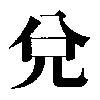 Trigram 2 is the Lake (duì or tui), the big body of water. The trigram represents the joyous and open.
Trigram 2 is the Lake (duì or tui), the big body of water. The trigram represents the joyous and open.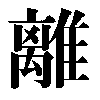 Trigram 3 is Fire (lí or li), the consuming energy, which is also one of the five Chinese elements. The trigram represents the clinging and radiance. It also stands for breaking free and departing.
Trigram 3 is Fire (lí or li), the consuming energy, which is also one of the five Chinese elements. The trigram represents the clinging and radiance. It also stands for breaking free and departing.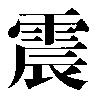 Trigram 4 is Thunder (zhèn or chen), the powerful voice of heaven. The trigram represents the arousing and shaking, what disturbs and unsettles, and therefore what triggers change. A force that can be destructive as well as constructive.
Trigram 4 is Thunder (zhèn or chen), the powerful voice of heaven. The trigram represents the arousing and shaking, what disturbs and unsettles, and therefore what triggers change. A force that can be destructive as well as constructive.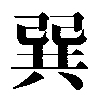 Trigram 5 is Wind (xùn or sun), the movement of air, which is not one of the five Chinese elements — but wood is, and the trigram contains that meaning, too. The trigram represents the gentle and obedient, but also the ground, which is where the wind is felt and shows its power.
Trigram 5 is Wind (xùn or sun), the movement of air, which is not one of the five Chinese elements — but wood is, and the trigram contains that meaning, too. The trigram represents the gentle and obedient, but also the ground, which is where the wind is felt and shows its power.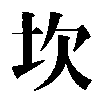 Trigram 6 is Water (kan or k'an), which is one of the five Chinese elements. The trigram represents the abysmal, the gorge, since that's where the water naturally travels. The nature of water is to flow to the lowest place, as is pointed out in Chinese philosophy — for example the Tao Te Ching.
Trigram 6 is Water (kan or k'an), which is one of the five Chinese elements. The trigram represents the abysmal, the gorge, since that's where the water naturally travels. The nature of water is to flow to the lowest place, as is pointed out in Chinese philosophy — for example the Tao Te Ching.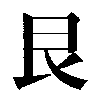 Trigram 7 is the Mountain (gèn or ken), rooted in the earth and towering towards heaven. The trigrams represents stillness and they bound, since a mountain remains where it is, seemingly forever.
Trigram 7 is the Mountain (gèn or ken), rooted in the earth and towering towards heaven. The trigrams represents stillness and they bound, since a mountain remains where it is, seemingly forever.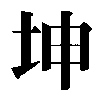 Trigram 8 is Earth (kun or k'un), consisting of three broken Yin lines. Yin stands for earth, dark, and cold. It's the symbol of the female principle in ancient Chinese tradition. The trigram for earth, then, is all about Yin.
Trigram 8 is Earth (kun or k'un), consisting of three broken Yin lines. Yin stands for earth, dark, and cold. It's the symbol of the female principle in ancient Chinese tradition. The trigram for earth, then, is all about Yin.

































































